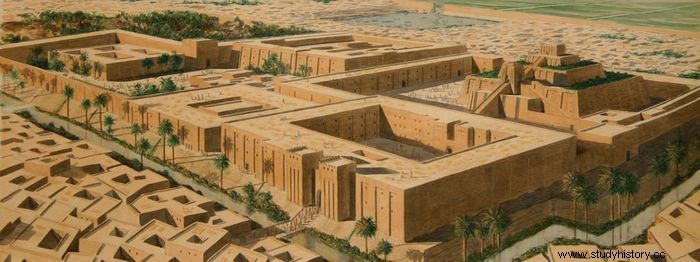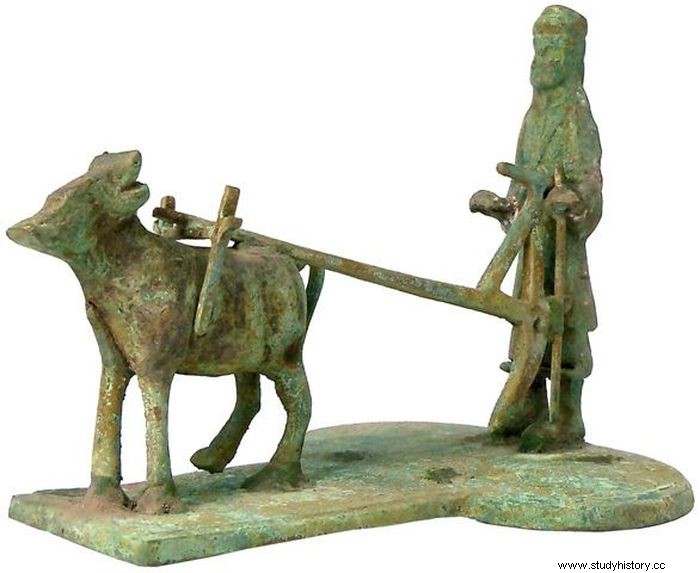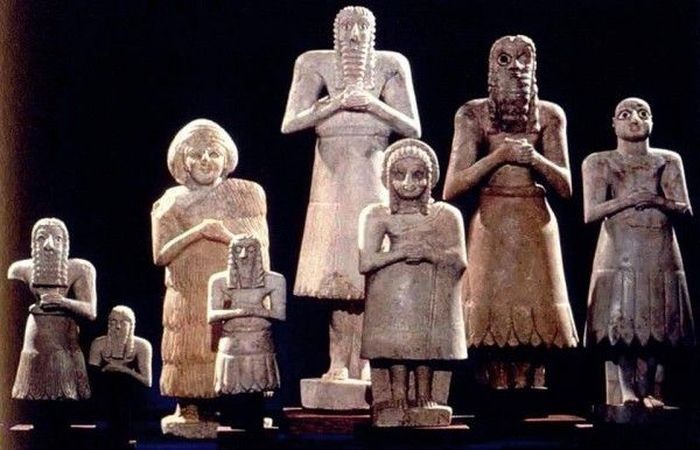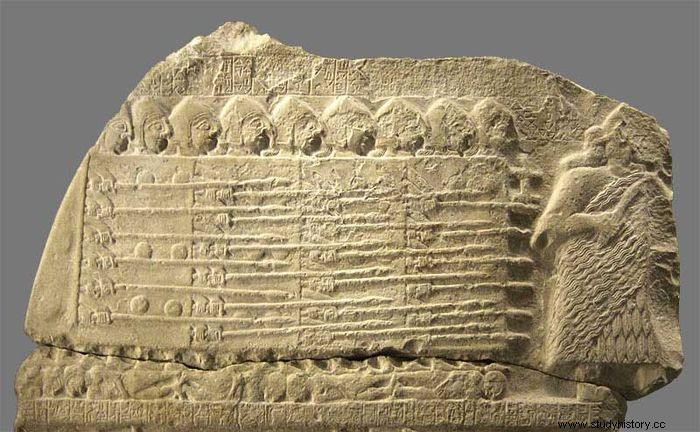Mesopotamia is derived from Greek words meaning "land between the rivers". The rivers Tigris and Euphrates are the names of the rivers. The first inhabitants of this area, the early Sumerians, did not speak Greek; many years later, the Greek-speaking Alexander the Great conquered this territory and took with him his culture.
Mesopotamia is considered the birthplace of civilization. Large cities flanked the rivers, and here great improvements took place. At first glance, however, Mesopotamia does not seem to be a suitable place for a civilization to grow. It is quite hot and dry. Lower Mesopotamia receives extremely little rain. Snowmelt in the mountains near the surface water of these two rivers caused annual floods every year. These floods lay silt, fertile, rich soil on the banks of rivers. Mesopotamia is located inside the fertile crescent, a crescent-shaped region in the Middle East with fertile soil.
The ancient Sumerians were the first people to settle in Mesopotamia and establish a huge civilization. Sumer was mankind's first wonderful civilization. During the fertile crescent, the Sumerians learned about agriculture on a large scale. Sumerian technological achievements such as canals and plows helped their success. Sumer became so good at growing food over time that they were able to spend more resources on building cities and temples. Even now, relics of Sumerian inventions can be seen in agriculture, language, mathematics, religion and astronomy.
The origins of Sumerian settlements

Villages began to appear in Mesopotamia about 10,000 XNUMX years ago. Even as they continued to hunt and gather, the people living in the area kept animals and grew grain. Over time, these communities grew in size, and the inhabitants became increasingly dependent on agriculture.
Archaeologists are still unsure what life was like for these ancient peoples. However, common features in ceramic designs and stamp seals found on a number of containers imply that a form of administrative power arose between 6,000 and 7,000 years ago.
Meanwhile, in a place known as Eridu, people began to build a series of mudstone temples. The city seems to have been established around 5400 BCE until it was deserted for well around 600 BCE. Even in ancient times, Eridus' fame was legendary and was said to have been built by the gods themselves. However, archaeologists had read about Eridus' presence in ancient manuscripts long before they discovered it.
A Sumerian plaque reads:"After kinship fell from heaven, Eridu became the seat of royalty."
At about 7,400 years old, Eridu is one of the oldest cities of mankind, but it is far from the oldest. Atalhöyük, located just north of the fertile crescent, is the current top candidate for the earth's earliest metropolis. Atalhöyük was founded 9,600 years ago and lasted for millennia before being wiped out just decades before Eridu.
Eridu, on the other hand, was just the beginning of Sumer. Ur, Kish and Uruk were among the hundreds of cities that made up civilization. Eridus' power would diminish over time, and Uruk would assume a greater role. At its peak 4,800 years ago, Uruk was the world's largest metropolis. According to some estimates, the city had a population of 80,000 15 individuals when the total human population was about XNUMX million.
Early Sumerian city-states
Sumer was divided into about a dozen distinct city-states by the end of the fourth millennium BCE, with canals and boundary stones defining the boundaries. Each was based on a temple dedicated to the city's patron god or goddess. A priest known as ensi or king known as lugal ruled the city and performed the religious rituals during this period.
From north to south were the most important Sumerian cities:
- Mari
- Agade
- Kish
- Borsipas
- Nippur
- Is in
- adab
- Shuruppak
- Girsu
- Lagash
- Bad-Tibira
- Uruk
- Larsa
- Ur
- eridu
Smaller cities:
- Sippar
- Kutha
- Dilbat
- Marad
- Kisurra
- Zabala
- Umma
- Kisiga
- Sky
- Hamazi
- Eshnunna
- Akshak
- Zimbir
Ubaid Period
During the Ubaid era, the neighboring town of Uruk took over the ancient Sumerian religious center of Eridu in size. This led to the establishment of a distinctive type of good quality painted pottery throughout Mesopotamia and the Persian Gulf. The archeological transformation from the Ubaid to Uruk periods is defined by a gradual movement from locally made painted pottery on a slow wheel to a wide range of unpainted pottery mass-produced by experts on fast wheels. The exact date of the shift from Ubaid 4 to Early Uruk is unknown, but calibrated radiocarbon dates on Tell Awayli suggest that it occurred around 4500 BCE.
Uruk Period
During the Uruk period from 4500 to 3100 BCE, several large temple-centered communities with centralized administrations were established. This development was possible due to the volume of trade products that were disseminated across the canals and rivers of southern Mesopotamia, and employed specialized personnel. In addition, Sumerian cities used slave labor captured from the hill country during the Uruk period, as seen in the earliest texts. As a result, artifacts and even colonies from this Uruk civilization have been found over a large area.
The Uruk-era civilization, spread by Sumerian traders and immigrants, affected all the surrounding peoples, who developed their equivalent and competed for economies and civilizations through the ages. However, Sumerian cities could not maintain distant, long-range colonies of military power.
The end of the Uruk period corresponded to the Priora oscillation, a dry period that lasted from 3200 to 2900 BCE. This dry period signaled the end of the Holocene climatic optimum, which lasted about 9,000 to 5,000 years ago. From the beginning of historical records, the restrictions for Sumerians happened to be towards southern Mesopotamia. However, early monarchs such as Lugal-Anne-Mundu extended to surrounding territories as far as the Mediterranean.
Early Dynamic Period
The Sumerian royal list tells of the early dynasties. As with many other ancient lists of rulers, it may contain mythological names. Etana, the 13th king of Kish's first dynasty, is the first monarch on the list whose names have been discovered elsewhere. The first monarch recognized by archaeological evidence in the Gilgamesh epic is Enmebaragesi of Kish, the 22nd and last king of that dynasty, whose name is also mentioned and who may have ruled when the dominion was moved from Kish Uruk again. As a result, Gilgamesh has been considered a historical king by Uruk.
Technology Innovations

The Sumerians' efforts to turn the desert into an oasis were heavily dependent on innovation. But unfortunately, one of their most useful inventions was also one of the most basic:the plow.
Around 3500 BCE, the first plow appeared. By 1500 BC, the Sumerians had also developed a soap plow, which allowed farmers to plow and plant at the same time as their animals. The Sumerian Farmer's Almanac also included instructions on how to increase agricultural crops through tillage and irrigation, with permission from the gadgets.
All the inventions helped to maintain a growing population and the growing system of rulers and religion. Their efforts in writing, mathematics and religion expanded as their cities grew. The Sumerians were responsible for inventing one of the earliest writings, cuneiform, as early as 5,000 years ago. Sumerian inscriptions on clay and stone depicted Sumerian history, monitored the trade and transit of grain and other objects, and even contained cooking instructions and obscenities. Thousands of Sumerian tablets are left in museums around the world, in need of translation. In addition to wagons on wheels, the 60-minute hour and probably the earliest recorded work of literature, "The Epic of Gilgamesh", the Sumerians produced or used a wide range of other more modern apparent technologies.
Agriculture and farming of the early Sumerian
The Sumerians followed the agricultural lifestyle introduced to Lower Mesopotamia and used irrigation techniques similar to Egypt's. Residence for 89 percent of the people was in the cities due to which irrigation development was linked to urbanization.
Planting of crops such as barley, lentils, chickpeas, wheat, dates, onions, garlic, lettuce, leeks and mustard took place here. Breeding of cattle, sheep, goats and pigs took place during this era. Their primary carnivores were oxen, while their main transport animals were donkeys or horse birds. In addition, Sumerians hunted birds and gazelles and caught a lot of fish.
Irrigation was extremely important in Sumerian agriculture. Shadufs, canals, canals, dikes, overflows and reservoirs water the land. The regular strong floods in the Tigris, and to a lesser extent the Euphrates, necessitated the maintenance of the canal and the removal of silt and the replacement of survey marks and boundary stones. The government demanded that the inhabitants work in a sausage on the canals, but the wealthy were exempt.
Using canals, farmers flood their fields and then drain the water after the flood season. Then they let the bulls stamp on the ground and kill the weeds. Before sowing seeds, they plowed, harrowed, scraped the ground three times and crushed it with a mattock. Unfortunately, the significant evaporation rate led to more salinization of the crops. During the Ur III period, farmers had switched from wheat to the more salt-tolerant barley as their main crop.
The Sumerians harvested in three-man teams consisting of a harvesting machine, a binder and a scrub organizer during the dry autumn season. Farmers wanted to remove the grain heads from the stalks using threshing wagons and then loosen the grain with a threshing sledge.
Early Sumerian cultures
The two primary centers of Sumerian culture are Eridu in the south and Nippur in the north. Consequently, the Sumerian religion was divided into Eridu and Nippur.
The deity Enlil, whose sanctuary Nippur had built around, was the lord of the ghost land. His gifts to mankind are the spells and incantations that accompany the spirit of good and evil. He created the planet shaped like a mountain, and the animals he lived underground.
Enki, the deity of the benefactor, lord of the abyss, a healer and friend of mankind, had given us the art and science of civilization, industry, and manners. The first law book was his invention. Eridu was originally a port city, and its international trade and interactions with other countries undoubtedly influenced the development of culture.
But long before history was written, the civilizations Eridu and Nippur had merged. While Babylon may have been an Eridu colony, Eridu's immediate neighbor, Ur, may have been a Nippur colony. However, Eridus' influence was strongest in the mixture of the two cultures. According to ancient Sumerian flood history, the establishment of city-states was a method of ensuring peace, comparable to the Epic of Gilgamesh. Old Sumerian treaties show a preference for solving problems through negotiations. For the Sumerians, trade and commerce were preferable to war.
Although women were protected by late Sumerian law and could achieve a greater position in Sumer than in other modern civilizations, men still dominated the culture. There is ample evidence that the Sumerians had a musical inclination. It seems to be an essential aspect of Sumerian religious and social life. In Sumer the lyre was quite popular.
Religion of the early Sumerian

Sumer was a polytheistic or henotheistic culture, like many other cities in Asia Minor and the Mediterranean. With every city-state having its protectors, temples, and priestly kings, there was no set of gods; yet the Sumerians were probably the first to write down their faith. As a result, Sumerian ideas influenced Mesopotamian mythology, religion, and astrology.
The Sumerians primarily worshiped Anu, which was comparable to "heaven" in Sumerian, the term "an" meant "heaven", and his wife "Ki", which was equivalent to "earth". Anunnaki is the reference given to the gods collectively. The belief was that humans were made of clay by the gods to serve them. Earthquakes and storms were common ways for the gods to show their rage and frustration:the idea of Sumerian religion was that humanity was at the mercy of the gods.
The Sumerians believed that the cosmos consists of a flat disk encased in a tin dome. The Sumerian life after death meant descending into a gloomy underworld where one would spend eternity like a miserable Gidim (ghost).
Sumerian temples had a courtyard with a purification pond (Abzu). A central nave ran the length of the temple, with aisles on each side. The priests wanted quarters that flank the hallways. The platform and a brick table for animal and vegetable victims would be at one end. Near the temples, granaries and warehouses were common. After a while, the Sumerians began to build ziggurats, multi-layered square structures created as a sequence of rising terraces.
Early Sumerian fashion
The Sumerian economy developed by exporting and trading scarce oil and wool. Wool was the most important product they used to make garments, tapestries and ornaments. Women were the ones who made the textiles. After spinning and weaving the wool, Sumerian men dyed the finished garment. Both men and women wore Kaunakes, a fleece-like cloth. The wearer's position in a society regulated the length of the skirts. Kingdoms and gods wore long skirts, while servants, slaves, and soldiers wore short skirts. The skirt was wrapped around the body and fastened with a belt.
The development of weaving defined the culture of the Sumerian civilization in Mesopotamia during the third millennium BCE. Weaving makes it possible to make huge tether rectangles that make it possible to cover the body. Statuettes and bas-reliefs from the Sumerian civilization show characters wearing both woven and tufted skirts, and demonstrate the shift from non-woven to woven clothing.
The wrapping and draping of the individual took place using a rectangular fabric. They wrapped it around the waist to form a wrap skirt. Later, a fibula was used to hold a rectangular fabric draped over the shoulder in place. The Assyrians, Greeks and Egyptians all wore garments inspired by this style.
Architectural advances
Minerals and trees were scarce on the Tigris-Euphrates plain. As a result, Sumerian buildings were built of plano-convex mudstone that was neither mortar nor cemented together. Because brick structures disintegrate over time, they were repeatedly demolished, leveled, and rebuilt. This continuous rebuilding gradually raised the level of the cities, and raised them above the surrounding plain.
The ziggurats, massive stacked platforms that supported temples, are the most spectacular and well-known Sumerian structures. The Sumerians were also responsible for the development of the arch. They were able to make a strong roof called a dome with this framework. They constructed this by setting up several arches. The use of exchanges, niches, half-columns took place in Sumerian temples and palaces, as were more advanced materials and methods.
Sumerian warfare and military

Although there may have been some professional troops in Sumer, there was no standing army. When the king, the high priest, and the council of elders decided that war was necessary, they called all free male inhabitants to arms. Each resident had to carry their weapons. Common weapons were bows, spears, slingshot, battle axes, maces and knives. Although many wore shields, protective armor was unusual. Professional troops wore copper helmets.
As Umma and Lagash did in 2525 BC, civilian armies emerge from their cities and meet on open ground when the cities go to battle. Each army's archers would fire at a range of 300 feet. The bombardment of these arrows was the cause of many deaths. Many more died when the slingshot threw spears and stones into the air. The army with the most remaining troops seemed to have won the day. This method was standard warfare strategy at the time.
A stele constructed by the ruler of Lagash to commemorate Lagash's triumph over neighbor and enemy city. The Stele of Vultures depicts soldiers in a phalanx formation, armed with spears and wearing copper helmets and short, armored cloaks for protection. The king of Lagash arrived at the battle in a heavy, heavy chariot drawn by four onagers, or half-wild donkeys, as usual during the period. The chariot, the helmet, the armor, the bronze axes and the phalanx formation in battle are Sumerian military innovations.
The conclusion
Although the Sumerians have made significant contributions to world civilization, this is a relatively new phenomenon. For years, their past remained buried under the sand, and historians misinterpreted all references to them in ancient writings since there was no recognized referent for the allusions. The Sumerians ushered in a new era of intensive agriculture and irrigation. Thanks to their inventions and breakthroughs, the Sumerians are easily among the most inventive nations in human prehistory and history. Unfortunately, the Sumerians' mistreatment of their land eventually led to their demise. While the Sumerians may have disappeared thousands of years ago, their influence and mystery live on now, affecting parts of our culture that we all take for granted.
